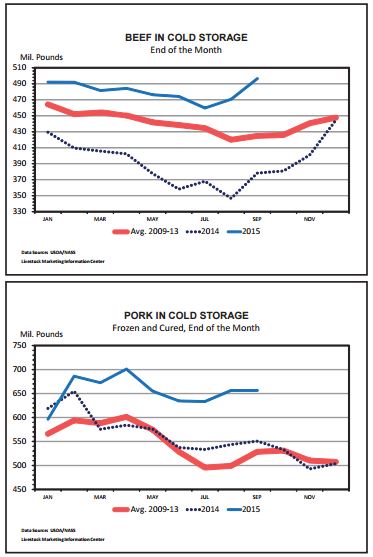



Chicken in Cold Storage Up but Turkey Down
US - USDA-NASS released the September Cold Storage report last week, and the general theme is there are some large supplies of frozen protein out there, write Steve Meyer and Len Steiner.The only tracked protein that had volume levels below year ago was turkey, down 6 per cent. This is due to an industry wide supply decrease caused by HPAI issues this past winter.
Chicken continued its trend of increasing stock numbers. Up in total 28 per cent yearover-year to almost 800 million pounds, increased levels of breast meat, leg quarters, and other chicken were the drivers of total volume growth.
All tracked categories of chicken were above year ago volumes though. This reflects increased chicken production so far this year, mainly due to heavier bird weights, while at the same time exports volumes have been much weaker (especially for dark meats).
Pork has also seen the results of elevated production levels in a market where exports have been weak this year and overall use has not kept pace with production.
Pork cold storage levels as of September 30th were 20 per cent above year ago and set a new record high for September, going back to the beginning of this series in 1973. Pork freezer inventory has been above year ago levels every month so far this year, except January.
The increase in volume month-to-month has moderated for pork however, with September numbers tracking near even to August.
Within specific categories, hams, loins, ribs, and variety meats all show double digit percentage increases in volumes, compared to year ago.
Conversely, belly stocks in cold storage were 68 per cent below September of 2014. This is the lowest level of bellies in cold storage since October of 2011 and supportive information with regards to their price strength in the market so far this year.
Moving on to beef, the trend continues of levels above year ago. Total beef in cold storage for September was just under 500 million pounds, up 31 per cent year-over-year and also a new record high for the end of September.
To be fair, beef cold storage levels were lower than normal during 2014 due to tight supplies, but even compared to the prior five year average stock levels were up 17 per cent for September.
The August and September volume increases are also both counter-seasonal. The only categories tracked in frozen beef are “boneless” and “bone-in”. Boneless beef makes up the majority (92 per cent) of September 30th’s total frozen beef number – which is a fairly normal proportion.
Comparing the categories year-over-year, boneless beef is up 36 per cent while bone-in volume is down 4 per cent. Relating this to Australian beef imports, mainly composed of manufacturing lean beef, it could be inferred that even if the flow of Australian product into the US slows there are ample stores of lean boneless product for the near future.
Combing pork and beef with veal and lamb/mutton volumes in cold storage (both of which are also above year ago numbers) sums to a total red meat volume of 1.2 billion pounds, up 24 per cent from 2014. This is still below the total red meat April volume, which is the high for 2015 so far.










